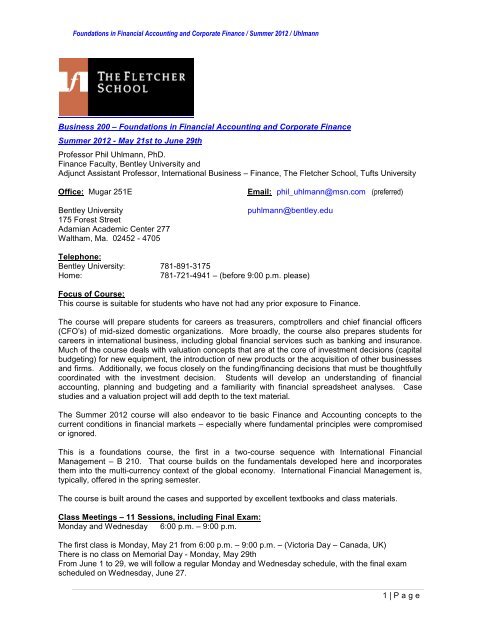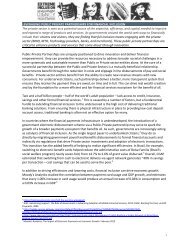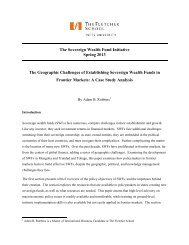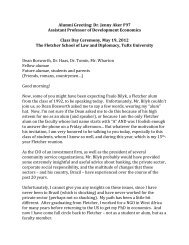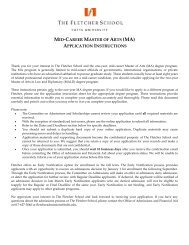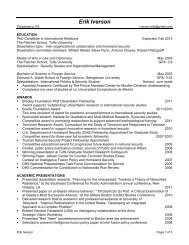EC 112 – Principles of Macroeconomics - Tufts University
EC 112 – Principles of Macroeconomics - Tufts University
EC 112 – Principles of Macroeconomics - Tufts University
- No tags were found...
You also want an ePaper? Increase the reach of your titles
YUMPU automatically turns print PDFs into web optimized ePapers that Google loves.
exceeds two hundred fifty units. If the policyholder is an undertakingbelonging to a group subject to the requirement to draw up consolidatedaccounts, the above conditions apply to the group’s consolidated accounts;s) undertaking: the authorised insurance or reinsurance undertaking;t) insurance undertaking: the undertaking authorised according to theprovisions laid down in Community directives on direct insurance;u) insurance undertaking authorised in Italy or Italian insuranceundertaking: the undertaking with head <strong>of</strong>fice in Italy and the Italianbranch <strong>of</strong> an insurance undertaking with head <strong>of</strong>fice in a third country,authorised to pursue insurance business or operations according to article2;v) EU insurance undertaking: the undertaking with head <strong>of</strong>fice andcentral administration in a member State <strong>of</strong> the European Union other thanItaly or in a State belonging to the European Economic Area, authorisedaccording to the provisions in <strong>EC</strong> directives on direct insurance;z) third-country insurance undertaking: the insurance undertakingwith head <strong>of</strong>fice and central administration in a State not belonging to theEuropean Union or to the European Economic Area, authorised to pursueinsurance business or operations according to article 2;aa) insurance holding company: a parent undertaking the sole or mainbusiness <strong>of</strong> which is to acquire controlling interests and to manage suchholdings and turn them to pr<strong>of</strong>it, where those subsidiary undertakings areeither exclusively or mainly insurance undertakings, third-countryinsurance undertakings or reinsurance undertakings, one at least <strong>of</strong> suchsubsidiary undertakings being an insurance undertaking with head <strong>of</strong>ficein the territory <strong>of</strong> the Italian Republic, provided that it is not a mixedfinancial holding company according to the relevant provisions <strong>of</strong>Community regulations on the supplementary supervision <strong>of</strong> undertakingsbelonging to a financial conglomerate;bb) mixed-activity insurance holding company: a parent undertakingother than an insurance undertaking, a third-country insuranceundertaking, a reinsurance undertaking or an insurance holding company,one at least <strong>of</strong> its subsidiary undertakings being an insurance undertakingwith head <strong>of</strong>fice in the territory <strong>of</strong> the Italian Republic, provided that it isnot a mixed financial holding company according to the relevant provisions<strong>of</strong> Community regulations on the supplementary supervision <strong>of</strong>undertakings belonging to a financial conglomerate;cc) reinsurance undertaking: an undertaking exclusively authorised tothe pursuit <strong>of</strong> reinsurance, other than an insurance undertaking or a thirdcountryinsurance undertaking, the main business <strong>of</strong> which consists inaccepting risks ceded by an insurance undertaking, an insuranceundertaking with head <strong>of</strong>fice in a third country or other reinsuranceundertakings;7
Foundations in Financial Accounting and Corporate Finance / Summer 2012 / UhlmannValuation ProjectThe primary objective <strong>of</strong> the business valuation project is to develop a comprehensive recommendation on acompany’s stock. Is the stock one that investors should buy or sell?To make a recommendation about the investment prospects <strong>of</strong> a stock, an analyst must have a thoroughunderstanding <strong>of</strong> the following three areas:1. Industry analysis.2. Historical financial performance <strong>of</strong> the company.3. Future financial prospects <strong>of</strong> the company.Industry analysis:An investor must fundamentally decide whether the risks posed by a particular industry are acceptable given hisor her other investments. This is the most basic question, “Do you like the industry?” Your report shouldcarefully scope the industry risks faced by an investor. Where does the company rank within the industry andwhat are the prospects for the industry itself <strong>–</strong> is this a rust belt industry or a high technology biomedical firm.What is the state <strong>of</strong> local, domestic and international competition in your industry?Historical Financial Performance:Using publicly available financial data, the annual reports <strong>–</strong> 10K and quarterly reports <strong>–</strong> 10Q, an analyst needs to<strong>of</strong>fer insight to how the company is performing. An EVA and MVA framework is helpful but investors typicallylook for deeper understanding <strong>of</strong> performance drivers and management’s ability to get the job done. WarrenBuffett, the legendary investor, looks for businesses where consumers have to use the product every day andwhere pr<strong>of</strong>its are stable in strong and weak business cycles. For example, Gillette sells razor blades, a productthat has consistent sales. Buffett also owns a paint company, the logic being that there is always something topaint.Future Financial Prospects:A spreadsheet valuation must be undertaken to estimate how the company will perform in the future and how thisimpacts on the stock price. Over the term, we will develop the tools necessary to perform the valuation.Students will receive assistance with this exercise, as appropriate. A careful review <strong>of</strong> each line item on theincome statement and how it is likely to change over the coming years is required. Clearly, the analyst providesa best estimate <strong>of</strong> performance and, over time, the market makes a judgment about the abilities <strong>of</strong> the analyst.The future prospects <strong>of</strong> the firm must consider whether the company can take its product to new markets. Theremust also be an assessment as to whether the firm will be an acquirer or potential target for another buyer in theevent the industry is currently consolidating, or likely to face such pressures in the medium term.In making your recommendation, there should be some comment on an appropriate investment holding period.For example, if the stock is currently selling at $50, your one year target price may be $75 and an investor mightwant to sell at that point. A prudent investor should always have an exit strategy, a function <strong>of</strong> price performanceand time. Time horizons may be driven by a need for cash to make other investments, for example, a biggerhouse or vacation home, even education expenses. Liquidity is important.Information and Data:A great deal <strong>of</strong> information is available on the websites <strong>of</strong> individual companies. The web is probably the bestplace to start. Fletcher students also have access to the Baker Library at Harvard Business School. This is anexcellent resource and the staff is very helpful. The NYSE site at nyse.com is very good. Ask if you would likesome help in choosing a company to study.Report Requirements:This is a group effort, with each group having three or four students. The final report must include a one-pageExecutive Summary clearly stating your recommendation. Additionally, Excel spreadsheets showing pertinentratio analyses and a fully developed valuation model are to be included. The three major headings, as raisedabove must be incorporated in the report, including any graphs and charts that serve to illuminate your keypoints. The report should not be more than ten pages in total. Please ask if you have questions.Due Dates:June 1 <strong>–</strong> One page proposal on the firm you wish to study <strong>–</strong> submission <strong>of</strong> this may be via email.June 25 <strong>–</strong> Final written report due <strong>–</strong> tentative date <strong>–</strong> we will discuss this and be sensible about completion.9 | P a g e


